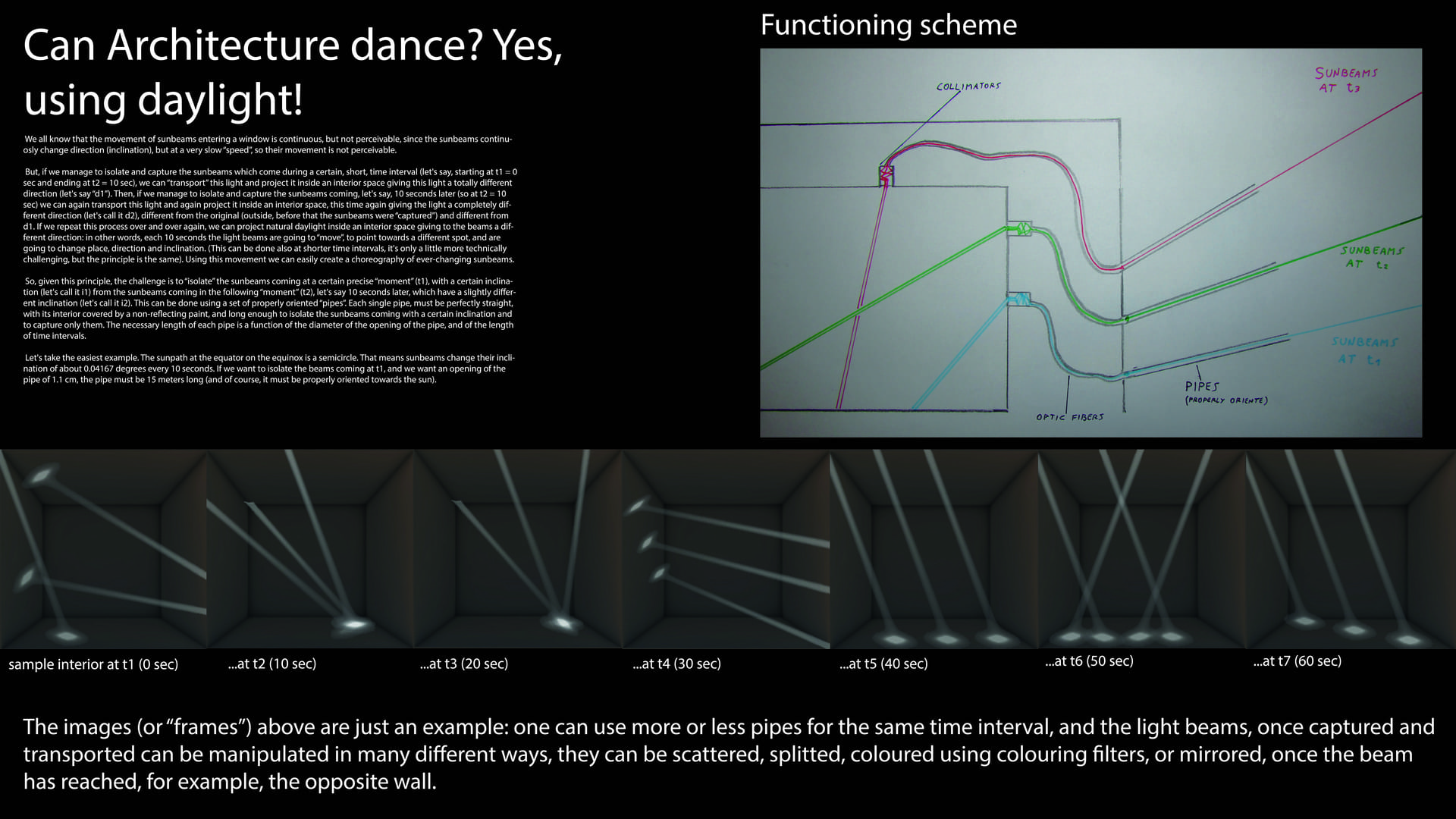Project Description
Architecture is not made only by its materiality, but it can be understood also as a game of light and shadows and, looking at the work of James Turrell, it becomes clear that architecture can be literally made of light. In a “parmenidean” way, we can consider dance as a sequence of single instants where in each instant the dancer is fixed. But all these single instants put one after the other in a short time, give the impression of movement. This abstraction is useful to understand the idea of movement (indeed, this is the core idea of cinematography). So, following this abstraction, we can see dance as a fast sequence of frames, where each frame is static, but all frames together give the impression of movement. So, how can we make an architecture that dances? The easiest way is using wind. "Dancing" wind sculptures have been made by architect César Manrique. But also daylight can be used to create a “dancing architecture”. One trivial system is attaching many mirrors in different orientations to many little windmills. But this system uses an external force. I believe that a dancing architecture can be made using only the “movement” of the sunlight, using no moving parts. We all know that the movement of sunbeams entering a window is continuous, but not perceivable, since the sunbeams continuosly change direction (inclination), but at a very slow “speed”, so their movement is not perceivable. But, if we manage to isolate and capture the sunbeams which come during a certain, short, time interval (let's say, starting at t1 = 0 sec and ending at t2 = 10 sec), we can “transport” this light and project it inside an interior space giving this light a totally different direction (let's say “d1”). Then, if we manage to isolate and capture the sunbeams coming, let's say, 10 seconds later (so at t2 = 10 sec) we can again transport this light and again project it inside an interior space, this time again giving the light a completely different direction (let's call it d2), different from the original (outside, before that the sunbeams were “captured”) and different from d1. If we repeat this process over and over again, we can project natural daylight inside an interior space giving to the beams a different direction: in other words, each 10 seconds the light beams are going to “move”, to point towards a different spot, and are going to change place, direction and inclination. (This can be done also at shorter time intervals, it's only a little more technically challenging, but the principle is the same). Using this movement we can easily create a choreography of ever-changing sunbeams. So, given this principle, the challenge is to “isolate” the sunbeams coming at a certain precise “moment” (t1), with a certain inclination (let's call it i1) from the sunbeams coming in the following “moment” (t2), let's say 10 seconds later, which have a slightly different inclination (let's call it i2). This can be done using a set of properly oriented “pipes”. Each single pipe, must be perfectly straight, with its interior covered by a non-reflecting paint, and long enough to isolate the sunbeams coming with a certain inclination and to capture only them. The necessary length of each pipe is a function of the diameter of the opening of the pipe, and of the length of time intervals. Let's take the easiest example. The sunpath at the equator on the equinox is a semicircle. That means sunbeams change their inclination of about 0.04167 degrees every 10 seconds. If we want to isolate the beams coming at t1, and we want an opening of the pipe of 1.1 cm, the pipe must be 15 meters long (and of course, it must be properly oriented towards the sun). Of course each set of pipes would work only two days per year, so they must be mounted on a system which allows to reorient them every day. These are extreme dimensions, but if we think at museums installations, then we see that in such circumstances it can be done. Once the light is captured, it can be transported via optic fibers, then collimated with an optic collimator and then projected on the wanted direction. Of course more than one pipe can be used for the same time interval, creating therefore an architecture of different light beams and columns which continuosly change place and direction, like in a choreography. Then, all possible variations are allowed... A beam can be scattered, splitted, mirrored (once it reaches, for example, the opposite wall), and so on. Applications of this idea can be done in large public interior spaces, such as museums, or large cemeterial halls (e.g. the austro-german war memorial at Pordoi Pass and the war memorial at Tonale Pass).
